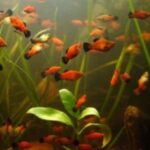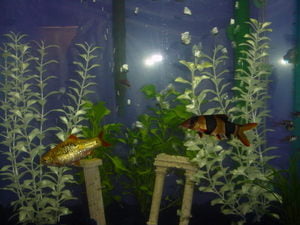The plecostomus (Hypostomus plecostomus) is called by many different names, including “sucker catfish”, “sucker fish”, “algae sucker” and “pleco”. There is a feeling among some aquarists that saying the full name “plecostomus” is bad luck. But whatever you call them, a plecostomus is a fascinating fish. They look drastically different from many other types of freshwater fish and have an otherworldly quality to them.
Appearance and Temperament
All plecostomus fish have a distinct sucker mouth used for feeding. In an aquarium, they often literally hang out the sides of the tank, or on ornaments. They constantly glean all surfaces for signs of organic growth such as algae. They will also eat sick or dead fish. As the fish ages, they can get aggressive with other fish – even other plecos.
A plecostomus tends to have a broad head, wide eyes and a long body with a sailfish-like dorsal fin that can be raised or lowered at will. Their bodies and tails are all covered with scales. They have whiskers like catfish called barbells. They aslo have spines, so handling them can be quite painful. However, that will most likely not happen. Unlike some other kinds of fish, a plecostomus usually doesn’t try to jump out of the tank.
Varieties
The original plecostomus originated in South America and could grow up to 24 inches long. This is still the main or common variety found in pet stores. Although all common plecostomus can potentially grow to 24 inches, they don’t always. Common plecostomus grow at different rates for each individual fish. They come in the usual mottled brown variety and an albino variety.
There are some varieties developed by aquarium hobbyists for the pet industry. Some varieties are specifically bred to grow only five inches long or less. These include the bristlenose plecostomus and the clown plecostomus. There is also a small species of sucker fish often called a plecostomus called an Otocinclus affins, or “algae eaters”.
One of the most starling varieties is called the zebra plecostomus – and for a good reason. They are vividly striped in black and white. They are not as hardy as some of the other varieties and tend to prefer a more carnivorous diet. But they average only about four inches in length.
Another striking variety of called the gold nugget plecostomus. They are brown with vivid yellow polka dots all over the body and a ridge of yellow on the dorsal fin. Some individuals even have all yellow mouths and bellies.
Quirks
A plecostomus will look as if it can blink. Actually, it’s not blinking – its eye rolling. It can be quite startling if you aren’t expecting it.
A plecostomus excretes a very long rope of waste – sometimes two or three times as long as the fish. Although it may look startling, the rope breaks down into smaller segments that are less obvious to see.
Additional References:
“Freshwater Aquariums for Dummies.” Maddy Hargrove & Mic Hargrov. Wiley; 2006.
FishLore.com. “Plecostimus, Pleco.” http://www.fishlore.com/Profiles-Pleco.htm
Robyn’s Pleco Care Page. http://www.fishpondinfo.com/fish/plecocare.htm
Author’s personal experience.





